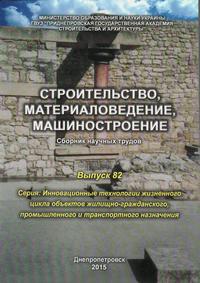Influence of dynamic loads from subway on stress-strain state of bearing structures
Keywords:
dynamic load, subway, high-rise buildings, stress-strain state of bearing structuresAbstract
Purpose. One of the main problems of modern urban planning is the density of buildings. In Kiev, as in many modern cities are actively constructed new modern high-rise buildings, as well as a new subway station. The article considers the problem of the influence of subway on the load-bearing structures of high-rise buildings. Methods. As an example, consider a monolithic building in Kiev, near-Svyatoshino-Brovarska subway line. In program complexes was modeled dynamic influence on the load-bearing structures of the building. Results. Based on the results of the calculations are made decisions to increase the reliability of the load-bearing structures and the building in general. Scientific novelty. In modern design and the further building of the city are not taken into account the impacts from subway lines, and such effect carries a destructive nature. It is proposed f method for simulation of dynamic loads and further consideration of such fluctuations. The practical importance. When taking into account the dynamic effects of the load-bearing structure of the building at the design stage, it is possible to significantly improve the quality and accuracy of the calculations that ensure the reliability of the building during its further operation.References
C.O. Aksoy, T. Onargan, The role of umbrella arch and face bolt as deformation preventing support system in preventing building damages. Tunneling and Underground Space Technology, doi:10.1016/j.tust.2010.03.004.
Aijun YAO, Xuejia YANG, Lei DONG, Numerical Analysis of the Influence of Isolation Piles in Metro Tunnel Construction of Adjacent Buildings. // Procedia Earth and Planetary Science 5 (2012), рр. 150 – 154.
Barabash M. Estimation metro influence on structure adjacent buildings/ M. Barabash // Materials of International Conference Seismics-2014 “Seismic resistance and rehabilitation of buildings”, 29–30 May 2014, Tbilisi, Georgia. – P. 141–151
M.Barabash. Computer simulation of life cycle in building objects: Monograph / M.Barabash. – K.: ‘Stal’ Publ., 2014. – 301 p
Dimmock, P. & Mair, R.J., 2008. Effect of building stiffness on tunnelling-induced ground movement. Tunnelling and Underground Space Technology, 23(4), pp.438-450.
Jiangfeng Liu, Taiyue Qi, Zhanrui Wu, Analysis of ground movement due to metro station driven with enlarging shield tunnels under building and its parameter sensitivity analysis. // Tunnelling and Underground Space Technology, 2012, 28:287-296.
General principles for providing reliability and structural safety of buildings, structures and foundations: DBN V.1.2-14-2009. – [Valid from 01-12-2009]. – K.: Minregionbud of Ukraine, 2009. – 45 p. (building code of Ukraine).
Konstantinos Vogiatzis, Environmental ground borne noise and vibration protection of sensitive cultural receptors along the Athens Metro Extension to Piraeu // WSEAS TRANSACTIONS on ENVIRONMENT and DEVELOPMENT. - Issue 11, Volume 7, November 2011, с.359 – 370.
Mete Kun, Turgay Onargan, Influence of the fault zone in shallow tunneling: A case study of Izmir Metro Tunnel. // Tunnelling and Underground Space Technology. 33 (2013), рр. 34–45
Mohammad S. Pakbaz, S. Imanzadeh, K.H. Bagherinia, Characteristics of diaphragm wall lateral deformations and ground surfacesettlements: Case study in Iran-Ahwaz metro. Tunnelling and Underground Space Technology 35 (2013) рр. 109–121
Попов Н.Н., Расторгуев Б.С. Забегаев А.Б. Расчет конструкции на динамические специальные нагрузки. - М.: Высшая школа, 1992.
Downloads
Issue
Section
License
Редакція Видання категорично засуджує прояви плагіату в статтях та вживає всіх можливих заходів для його недопущення. Плагіат розглядається як форма порушення авторських прав і наукової етики.
При виявлені у статті більш ніж 25% запозиченого тексту без відповідних посилань та використання лапок, стаття кваліфікується як така, що містить плагіат. У цьому випадку стаття більше не розглядається редакцією, а автор отримує перше попередження.
Автори, в статтях яких повторно виявлено плагіат, не зможуть публікуватися в усіх журналах Видавництва ДВНЗ «Придніпровська державна академія будівництва та архітектури».
Автори, які публікуються у цьому журналі, погоджуються з наступними умовами:
- Автори залишають за собою право на авторство своєї роботи та передають журналу право першої публікації цієї роботи на умовах ліцензії Creative Commons Attribution License, котра дозволяє іншим особам вільно розповсюджувати опубліковану роботу з обов'язковим посиланням на авторів оригінальної роботи та першу публікацію роботи у цьому журналі.
- Автори мають право укладати самостійні додаткові угоди щодо неексклюзивного розповсюдження роботи у тому вигляді, в якому вона була опублікована цим журналом (наприклад, розміщувати роботу в електронному сховищі установи або публікувати у складі монографії), за умови збереження посилання на першу публікацію роботи у цьому журналі.
- Політика журналу дозволяє і заохочує розміщення авторами в мережі Інтернет (наприклад, у сховищах установ або на особистих веб-сайтах) рукопису роботи, як до подання цього рукопису до редакції, так і під час його редакційного опрацювання, оскільки це сприяє виникненню продуктивної наукової дискусії та позитивно позначається на оперативності та динаміці цитування опублікованої роботи (див. The Effect of Open Access).

